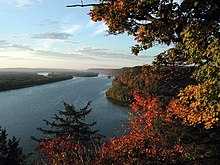Portal:Mississippi
 | |
 | |
Mississippi (/ˌmɪsəˈsɪpi/ ⓘ MISS-ə-SIH-pee) is a state in the Southeastern region of the United States. It borders Tennessee to the north, Alabama to the east, the Gulf of Mexico to the south, Louisiana to the southwest, and Arkansas to the northwest. Mississippi's western boundary is largely defined by the Mississippi River, or its historical course. Mississippi is the 32nd largest by area and 35th-most populous of the 50 U.S. states and has the lowest per-capita income. Jackson is both the state's capital and largest city. Greater Jackson is the state's most populous metropolitan area, with a population of 591,978 in 2020.
The state's history traces back to around 9500 BC with the arrival of Paleo-Indians, evolving through periods marked by the development of agricultural societies, rise of the Mound Builders, and flourishing of the Mississippian culture. European exploration began with the Spanish in the 16th century, followed by French colonization in the 17th century. Mississippi's strategic location along the Mississippi River made it a site of significant economic and strategic importance, especially during the era of cotton plantation agriculture, which led to its wealth pre-Civil War, but entrenched slavery and racial segregation. On December 10, 1817, Mississippi became the 20th state admitted to the Union. By 1860, Mississippi was the nation's top cotton-producing state and slaves accounted for 55% of the state population. Mississippi declared its secession from the Union on January 9, 1861, and was one of the seven original Confederate States, which constituted the largest slaveholding states in the nation. Following the Civil War, it was restored to the Union on February 23, 1870. Mississippi's political and social landscape was dramatically shaped by the Civil War, Reconstruction era, and civil rights movement, with the state playing a pivotal role in the struggle for civil rights. From the end of the Civil War to the 1960s, Mississippi was dominated by socially conservative and segregationist Democrats dedicated to upholding white supremacy.
Despite progress, Mississippi continues to grapple with challenges related to health, education, and economic development, often ranking low in national metrics for wealth, health care quality, and educational attainment. Economically, it relies on agriculture, manufacturing, and an increasing focus on tourism, highlighted by its casinos and historical sites. Mississippi produces more than half of the country's farm-raised catfish, and is a top producer of sweet potatoes, cotton and pulpwood. Others include advanced manufacturing, utilities, transportation, and health services. Mississippi is almost entirely within the east Gulf Coastal Plain, and generally consists of lowland plains and low hills. The northwest remainder of the state consists of the Mississippi Delta. Mississippi's highest point is Woodall Mountain at 807 feet (246 m) above sea level adjacent to the Cumberland Plateau; the lowest is the Gulf of Mexico. Mississippi has a humid subtropical climate classification.
Mississippi is known for its deep religious roots, which play a central role in its residents' lives. The state ranks among the highest of U.S. states in religiosity. Mississippi is also known for being the state with the highest proportion of African-American residents. The states governance structure is based on the traditional separation of powers, with political trends showing a strong alignment with conservative values. Mississippi boasts a rich cultural heritage, especially in music, being the birthplace of the blues and contributing significantly to the development of the music of the United States as a whole. (Full article...)
The Mississippi River is the primary river, and second-longest river, of the largest drainage basin in the United States. From its traditional source of Lake Itasca in northern Minnesota, it flows generally south for 2,340 miles (3,766 km) to the Mississippi River Delta in the Gulf of Mexico. With its many tributaries, the Mississippi's watershed drains all or parts of 32 U.S. states and two Canadian provinces between the Rocky and Appalachian mountains. The main stem is entirely within the United States; the total drainage basin is 1,151,000 sq mi (2,980,000 km2), of which only about one percent is in Canada. The Mississippi ranks as the thirteenth-largest river by discharge in the world. The river either borders or passes through the states of Minnesota, Wisconsin, Iowa, Illinois, Missouri, Kentucky, Tennessee, Arkansas, Mississippi, and Louisiana.
Native Americans have lived along the Mississippi River and its tributaries for thousands of years. Most were hunter-gatherers, but some, such as the Mound Builders, formed prolific agricultural and urban civilizations. The arrival of Europeans in the 16th century changed the native way of life as first explorers, then settlers, ventured into the basin in increasing numbers. The river served sometimes as a barrier, forming borders for New Spain, New France, and the early United States, and throughout as a vital transportation artery and communications link. In the 19th century, during the height of the ideology of manifest destiny, the Mississippi and several western tributaries, most notably the Missouri, formed pathways for the western expansion of the United States.
Formed from thick layers of the river's silt deposits, the Mississippi embayment is one of the most fertile regions of the United States; steamboats were widely used in the 19th and early 20th centuries to ship agricultural and industrial goods. During the American Civil War, the Mississippi's capture by Union forces marked a turning point towards victory, due to the river's strategic importance to the Confederate war effort. Because of the substantial growth of cities and the larger ships and barges that replaced steamboats, the first decades of the 20th century saw the construction of massive engineering works such as levees, locks and dams, often built in combination. A major focus of this work has been to prevent the lower Mississippi from shifting into the channel of the Atchafalaya River and bypassing New Orleans. (Full article...)- ... that the street from which Mississippi radio station WMPR broadcasts was renamed in honor of the station's longtime owner and general manager, former politician Charles Evers?
- ... that Jaz Brisack, leader of the movement to unionize Starbucks, was the first woman Rhodes Scholar at the University of Mississippi?
- ... that police in Indianola, Mississippi, shot an unarmed 11-year-old African-American boy after responding to his 9-1-1 call for help at his home?
- ... that Kamala, Percy Pringle and the Fabulous Freebirds got their first "big break" in International Championship Wrestling?
- ... that Rubel Phillips was the first Republican to run in the Mississippi gubernatorial election since 1947 when he ran in 1963?
- ... that John Berry Meachum anchored the Floating Freedom School in the Mississippi River under federal government protection?
- ... that the Enterprise, a black newspaper in Omaha, supported a separate African American department at the 1898 Trans-Mississippi Exposition?
- ... that a section of Mississippi Highway 489 was designated as the Jason Boyd Memorial Highway to commemorate the MDOT superintendent who was killed while removing debris from the road?

|
Hello! As a past or current member of WikiProject Mississippi, a WikiProject dedicated to developing and improving articles about Mississippi, you are cordially invited to edit, assess, and improve our coverage of all things Mississippi on Wikipedia! |
Topics: Constitution - Supreme Court - History - Music
Regions: Golden Triangle - Mississippi Plain - Mississippi Delta - Mississippi Gulf Coast - Natchez District - Pine Belt - Tennessee Valley
Cities: Biloxi - Clarksdale - Clinton - Columbus - Greenville - Gulfport - Hattiesburg - Jackson - Meridian - Olive Branch - Pascagoula - Pearl - Ridgeland - Southaven - Starkville - Tupelo - Vicksburg
Geography: Rivers - Lakes - Mountains - National forests - Islands - Wilderness areas - Natural disasters - Parks - State Parks
Industries: Agriculture - Oil
CDPs: Byram - Diamondhead - Kiln - Lyman - Pearlington - Saucier - Shoreline Park - West Hattiesburg
Metros: Gulfport‑Biloxi - Hattiesburg - Jackson - Memphis - Pascagoula
Statistics: Population
Lists: Mississippi-related lists
| Nickname | The Magnolia State |
|---|---|
| Motto | Virtute et armis (Latin) transl. By Valor and Arms |
| Flower | Magnolia |
| Rock | Petrified wood |
| Toy | Teddy bear |
| Other | Mississippi Symbols for more |
 |
Here are some tasks awaiting attention:
|
The following Wikimedia Foundation sister projects provide more on this subject:
-
Commons
Free media repository -
Wikibooks
Free textbooks and manuals -
Wikidata
Free knowledge base -
Wikinews
Free-content news -
Wikiquote
Collection of quotations -
Wikisource
Free-content library -
Wikispecies
Directory of species -
Wikiversity
Free learning tools -
Wikivoyage
Free travel guide -
Wiktionary
Dictionary and thesaurus
| Official State of Mississippi website |
- Mississippi Governor
- Mississippi Lieutenant Governor
- Mississippi Attorney General
- Mississippi Secretary of State
- Mississippi State Auditor
- Mississippi State Treasurer
- Mississippi State Insurance Commissioner
- Mississippi State Supreme Court
- Mississippi State Legislature
- U.S. Census Bureau Mississippi Data
- USDA Mississippi Statistical Facts
- USGS real-time, geographic, and other scientific resources of Mississippi












































